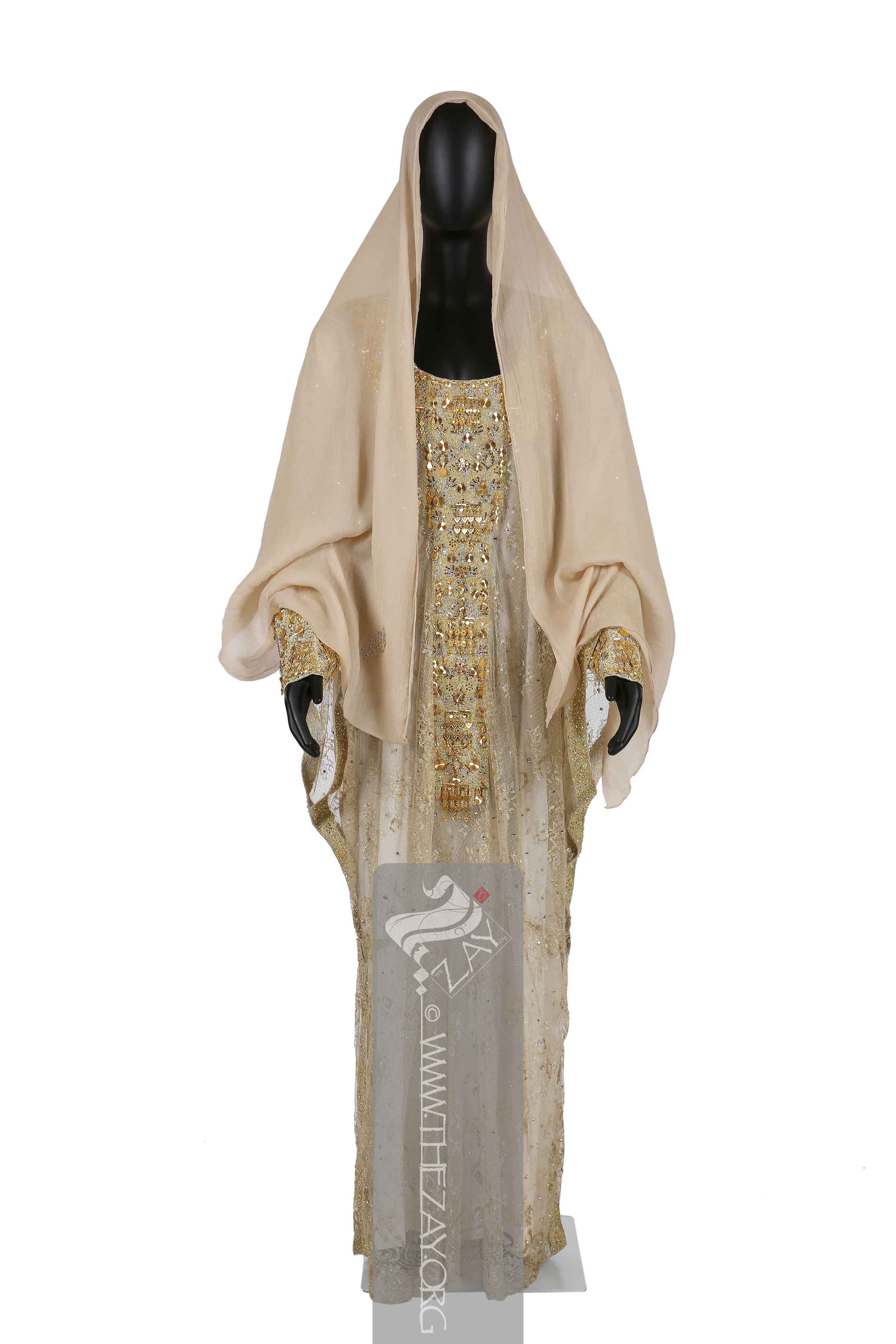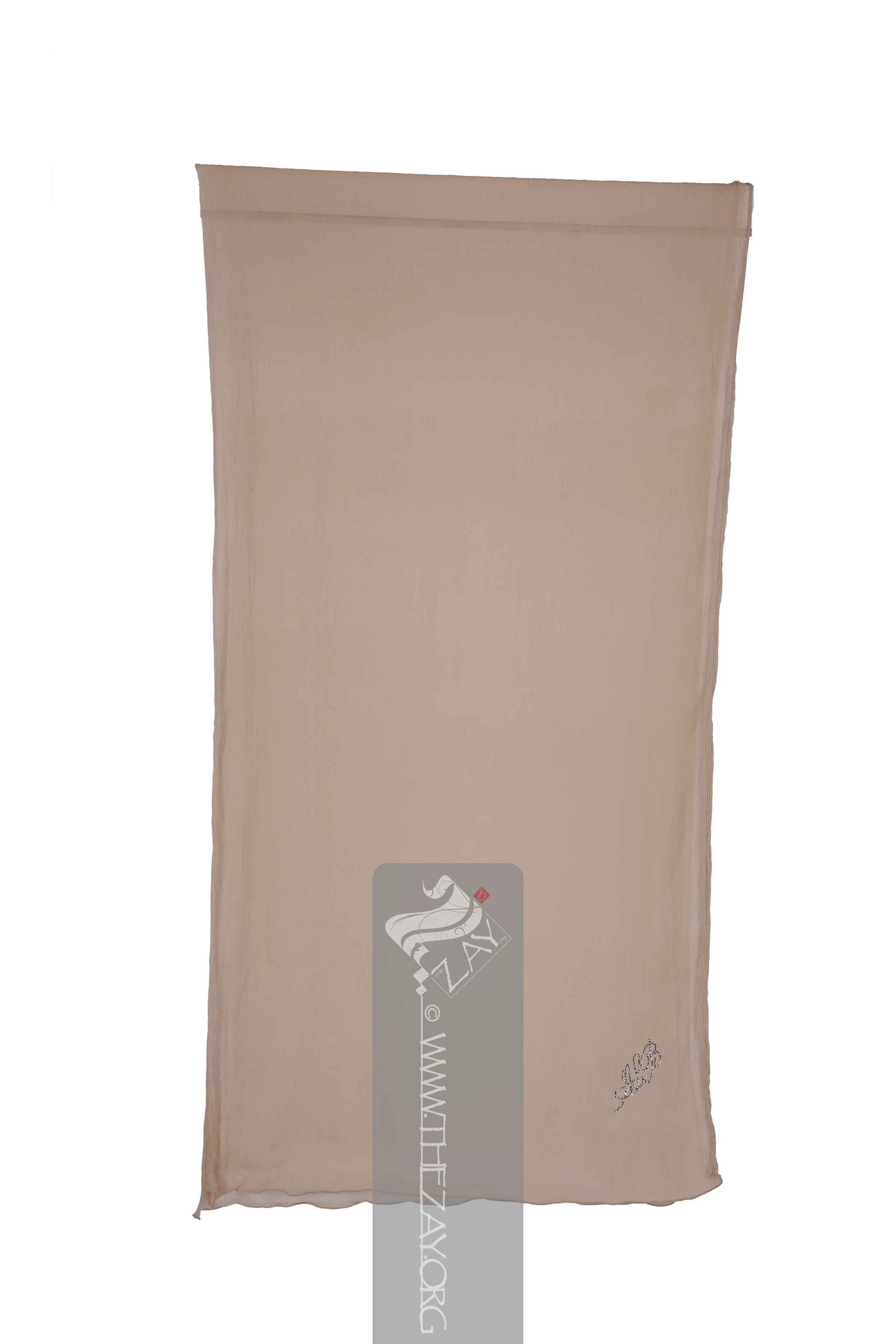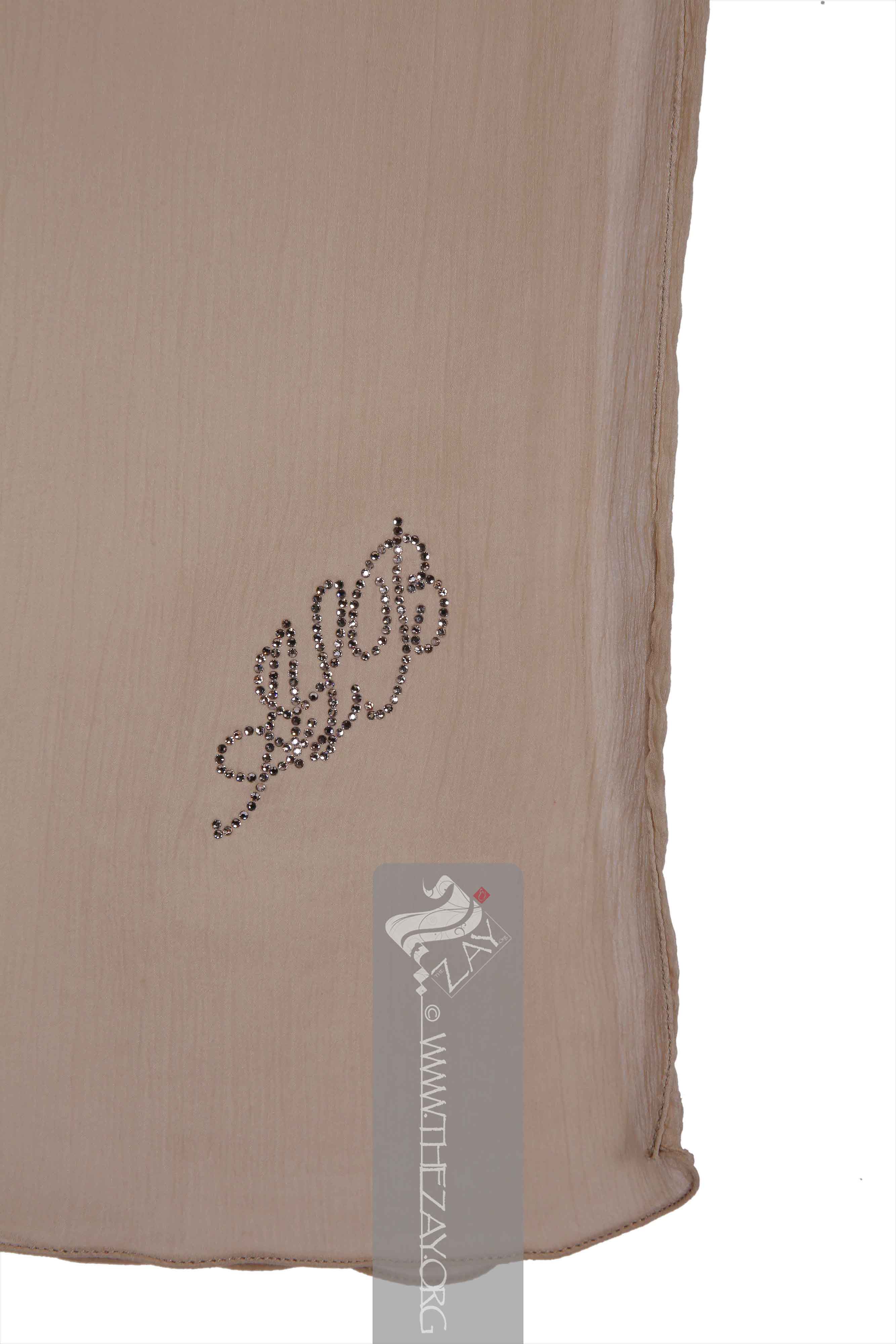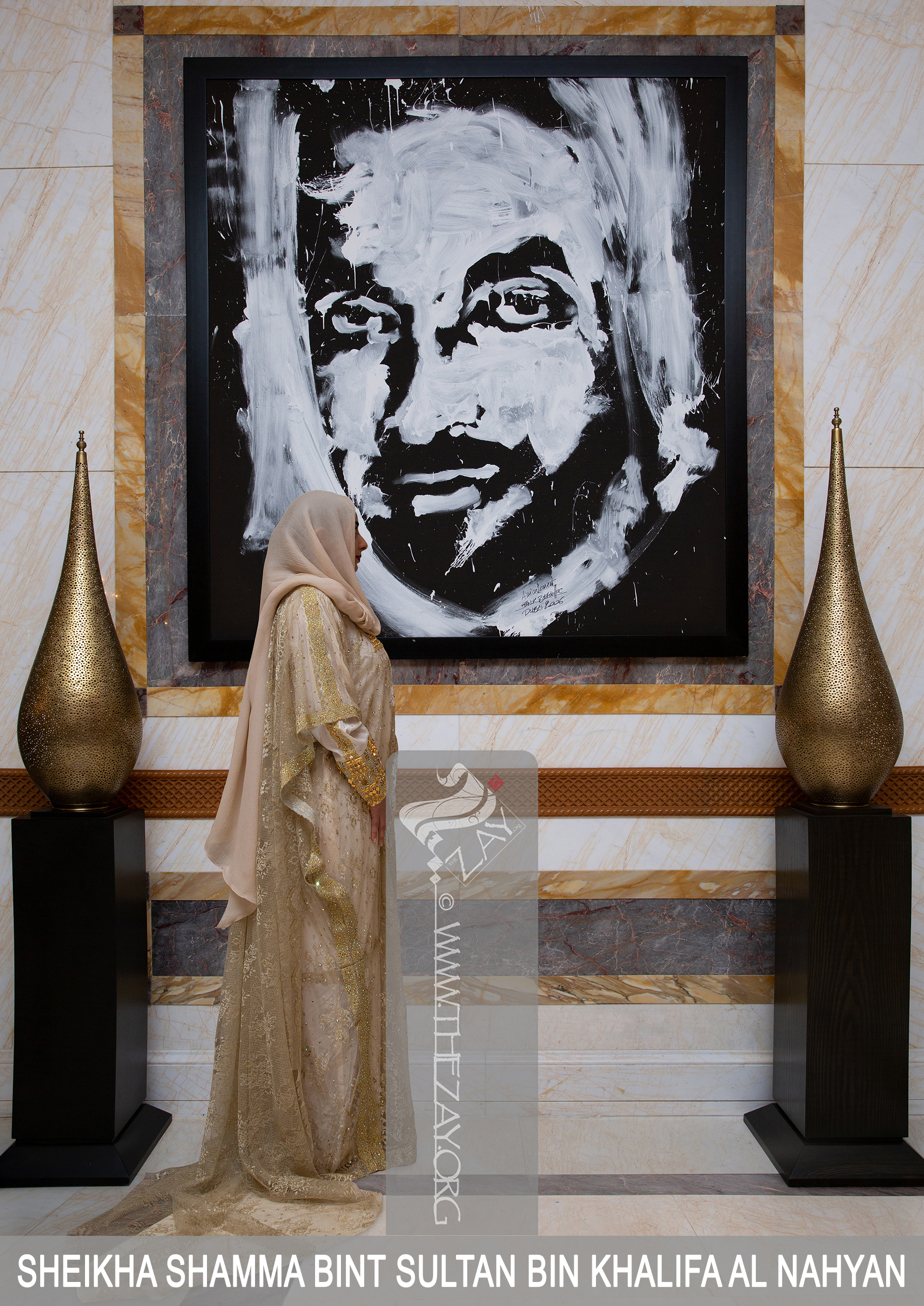Object Note This silk veil (
shaylah
Shaylah: (Colloquial Gulf Arabic), a length of fabric used as shawl, head cover or veil. Also known as (wigāyah) or (milfa’), generally made from sheer fabrics such as tulle (tūr), cotton gauze (wasmah
Wasmah: (Arabic: woad), is derived from the woad herb (wasmah) used to dye the cotton gauze black. It is mainly used for headcovers or veils and overgarments in most of the Arab gulf region.) (nidwah) or (Nīl), or silk chiffon (sarī). safwah
Ṣafwah: (Arabic: crème de la crème, or the best). Colloquially in the Arab gulf region it refers to high quality sheer, transparent chiffon silk.) is part of a three-piece ensemble, a combination overgarment tunic (
thawb_kandurah
Thawb_kandūrah: (colloquial, UAE), post-1990s the (Thawb_wa_kandūrah) ensemble of the eighties evolved where the overgarment (thawb) and tunic (kandūrah) became united at the neckline creating one outfit and inner tunic receding to act as lining.) (
ZI2021.500790 UAE) and a second silk veil (
shaylah
Shaylah: (Colloquial Gulf Arabic), a length of fabric used as shawl, head cover or veil. Also known as (wigāyah) or (milfa’), generally made from sheer fabrics such as tulle (tūr), cotton gauze (wasmah
Wasmah: (Arabic: woad), is derived from the woad herb (wasmah) used to dye the cotton gauze black. It is mainly used for headcovers or veils and overgarments in most of the Arab gulf region.) (nidwah) or (Nīl), or silk chiffon (sarī). tur
Tūr: (Arabised from French: tulle), refers to a net-like soft, fine silk, cotton, or nylon material, used for making veils and dresses. In colloquial Arabic the letter (L) is turned into (ra). ) (
ZI2021.500790a UAE) worn by Sheikhah Shamma bint Sultan bin Khalifa bin Zayed Al Nahyan when posing for a portrait for Draped in Heritage exhibition curated by The
Zay
Zay: (Arabic: costume, Pl. azyaā’), a set of clothes in a style typical of a particular country or historical period. Initiative in 2020.
Object History The ensemble was donated by Sheikhah Shamma bint Sultan bin Khalifa bin Zayed Al Nahyan, great-granddaughter of UAE founding father the late Sheikh Zayid bin Sultan AL Nahyan.
Sheikhah Shamma is a great supporter of The
Zay
Zay: (Arabic: costume, Pl. azyaā’), a set of clothes in a style typical of a particular country or historical period. Initiative’s efforts to preserve and document aspects of UAE heritage and history.
She holds a Master's degree in Sustainability Leadership from Cambridge University. As the CEO of Alliances for Global Sustainability, Co-Founder of Aurora50, and Honorary President of the Emirates Green Business Council, Sheikha Shamma is a highly regarded business leader and expert in the field of sustainability. In addition, she serves as a member of the UAE’s Circular Economy Council, the Yale Center for Environmental Law and Policy Advisory Board, and the Industry and Academic Advisory Board for the Academy of International Business MENA.
Sheikha Shamma also established the Circle of Hope foundation, resulting in the successful launch and operation of non-profit environmental initiatives, such as Mangroves 4 Mankind and Beacon of Hope.
Object Features The veil is made of simple, yet high quality, French silk
crepe
Crepe: (Latin: crispus; Old French: crespe – curled or frizzed), is a lightweight, crinkled fabric with a pebbled texture woven from a hand spun untreated or ‘in the gum’ silk yarn.
(
wigayah
Wigāyah: (Arabic: verb waqa: to protect), the term is applied to any fabric that is draped off the head to cover the upper portion of the body thus used as shawl, head scarf or veil (shaylah). Some can have a fringe (hāshīyah). The letter (qāf) is commonly pronounced (guh) colloquially rendering the term: wigāyah.). Apart from a machine stitched hem, the only other feature is a monogram created in Swarovski crystals.
This head veil (
shaylah
Shaylah: (Colloquial Gulf Arabic), a length of fabric used as shawl, head cover or veil. Also known as (wigāyah) or (milfa’), generally made from sheer fabrics such as tulle (tūr), cotton gauze (wasmah
Wasmah: (Arabic: woad), is derived from the woad herb (wasmah) used to dye the cotton gauze black. It is mainly used for headcovers or veils and overgarments in most of the Arab gulf region.) (nidwah) or (Nīl), or silk chiffon (sarī).) was used in conjunction with the second piece of the ensemble, the see-through silk tulle head veil (
shaylah
Shaylah: (Colloquial Gulf Arabic), a length of fabric used as shawl, head cover or veil. Also known as (wigāyah) or (milfa’), generally made from sheer fabrics such as tulle (tūr), cotton gauze (wasmah
Wasmah: (Arabic: woad), is derived from the woad herb (wasmah) used to dye the cotton gauze black. It is mainly used for headcovers or veils and overgarments in most of the Arab gulf region.) (nidwah) or (Nīl), or silk chiffon (sarī). tur
Tūr: (Arabised from French: tulle), refers to a net-like soft, fine silk, cotton, or nylon material, used for making veils and dresses. In colloquial Arabic the letter (L) is turned into (ra). ) and add more opaque, layer to cover properly in front of men, which is why it is referred to as
wigayah
Wigāyah: (Arabic: verb waqa: to protect), the term is applied to any fabric that is draped off the head to cover the upper portion of the body thus used as shawl, head scarf or veil (shaylah). Some can have a fringe (hāshīyah). The letter (qāf) is commonly pronounced (guh) colloquially rendering the term: wigāyah..
Both veils were reserved for indoor use, in female company. The lighter silk tulle veil would have been worn on the head at all times. As the fabric is quite sheer, this third part of the ensemble, the heavier and less opaque Emirati silk
crepe
Crepe: (Latin: crispus; Old French: crespe – curled or frizzed), is a lightweight, crinkled fabric with a pebbled texture woven from a hand spun untreated or ‘in the gum’ silk yarn.
head veil is kept about the person, or nearby, in case it is required to be put on as the wearer moves between rooms, for added coverage.
In earlier days a cloak (
abayah
‘Abāyah: (Arabic: cloak, Pl. ‘abāyāt, or ‘Ibī. In Classical Arabic: ‘abā’ah, pl: ‘abā’āt, synonyms: ‘Abā, ‘abāh, ‘abāt, dafah
Daffah : (Arabic: side, synonyms: ‘Abā, ‘abāyah, ‘abāh, ‘abāt, bisht or mishlaḥ), long, wide, and sleeveless outer cloak worn in public by both sexes. In time this article of dress evolved and changed in shape, style, and function., bisht
Bisht: (Arabic: bjd or bjād: cloak, Akkadian: bishtu or Persian: back, pl. bshūt synonyms: ‘Abā,‘abāyah, ‘abāh, ‘abāt, dafah
Daffah : (Arabic: side, synonyms: ‘Abā, ‘abāyah, ‘abāh, ‘abāt, bisht or mishlaḥ), long, wide, and sleeveless outer cloak worn in public by both sexes. In time this article of dress evolved and changed in shape, style, and function., or mishlaḥ), long, wide, and sleeveless outer cloak worn in public by men. In time this article of dress evolved and changed in shape, style, and function., or mishlaḥ), long, wide, and sleeveless outer cloak worn in public by both sexes. In time this article of dress evolved and changed in shape, style, and function.) would have been worn or a black head veil (
shaylah
Shaylah: (Colloquial Gulf Arabic), a length of fabric used as shawl, head cover or veil. Also known as (wigāyah) or (milfa’), generally made from sheer fabrics such as tulle (tūr), cotton gauze (wasmah
Wasmah: (Arabic: woad), is derived from the woad herb (wasmah) used to dye the cotton gauze black. It is mainly used for headcovers or veils and overgarments in most of the Arab gulf region.) (nidwah) or (Nīl), or silk chiffon (sarī).) but since the start of the millennium there has been a move towards the use of contemporary coloured fabrics and a more stylistic look. However, the ensemble still serves the purpose of covering the woman in accordance to the religious guidelines and social customs of the region.
In public areas, outside of the house or palace, the wearer continues to use the
abayah
‘Abāyah: (Arabic: cloak, Pl. ‘abāyāt, or ‘Ibī. In Classical Arabic: ‘abā’ah, pl: ‘abā’āt, synonyms: ‘Abā, ‘abāh, ‘abāt, dafah
Daffah : (Arabic: side, synonyms: ‘Abā, ‘abāyah, ‘abāh, ‘abāt, bisht or mishlaḥ), long, wide, and sleeveless outer cloak worn in public by both sexes. In time this article of dress evolved and changed in shape, style, and function., bisht
Bisht: (Arabic: bjd or bjād: cloak, Akkadian: bishtu or Persian: back, pl. bshūt synonyms: ‘Abā,‘abāyah, ‘abāh, ‘abāt, dafah
Daffah : (Arabic: side, synonyms: ‘Abā, ‘abāyah, ‘abāh, ‘abāt, bisht or mishlaḥ), long, wide, and sleeveless outer cloak worn in public by both sexes. In time this article of dress evolved and changed in shape, style, and function., or mishlaḥ), long, wide, and sleeveless outer cloak worn in public by men. In time this article of dress evolved and changed in shape, style, and function., or mishlaḥ), long, wide, and sleeveless outer cloak worn in public by both sexes. In time this article of dress evolved and changed in shape, style, and function. to cover up.
Keywords:
ghishwah
Ghishwah: (Arabic: ghashā: to cover), the term is applied to any sheer fabric such as shawl
Shawl: (Persian: shāl from Hindi: duśālā – Shoulder Mantle), a shawl is a South Asian version of a scarf worn or wrapped loosely over the shoulders and is usually made of wool. , head scarf
Scarf: (English), usually a rectangular piece of cloth loosely worn over the shoulders, upper body and arms, and sometimes also over the head. or veil (shaylah
Shaylah: (Colloquial Gulf Arabic), a length of fabric used as shawl, head cover or veil. Also known as (wigāyah) or (milfa’), generally made from sheer fabrics such as tulle (tūr), cotton gauze (wasmah
Wasmah: (Arabic: woad), is derived from the woad herb (wasmah) used to dye the cotton gauze black. It is mainly used for headcovers or veils and overgarments in most of the Arab gulf region.) (nidwah) or (Nīl), or silk chiffon (sarī).) if draped off the head to conceal the face, in Arab gulf dialect. 






